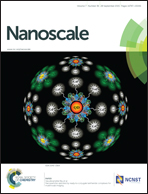Liquid-assisted tip manipulation: fabrication of twisted bilayer graphene superlattices on HOPG†
Abstract
We use the tip of a scanning tunneling microscope (STM) to manipulate single weakly bound nanometer-sized sheets on a highly oriented pyrolytic graphite (HOPG) surface through artificially increasing the tip and sample interaction by pretreatment of the surface using a liquid thiol molecule. By this means it is possible to tear apart a graphite sheet against a step and fold this part onto the HOPG surface and thus generate graphene superlattices with hexagonal symmetry. The tip and sample surface interactions, including the van der Waals force, electrostatic force and capillary attraction force originating from the Laplace pressure due to the formation of a highly curved fluid meniscus connecting the tip and sample, are discussed quantitatively to understand the formation mechanism of a graphene superlattice induced by the STM tip. The capillary force plays a key role in manipulating the graphite surface sheet under humid conditions. Our approach provides a simple and feasible route to prepare controllable superlattices and graphene nanoribbons and also to better understand the process of generation of a graphene superlattice on the surface of HOPG with the tip.


 Please wait while we load your content...
Please wait while we load your content...